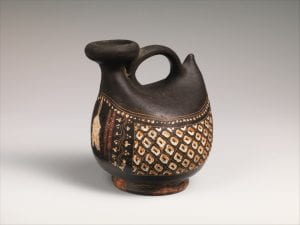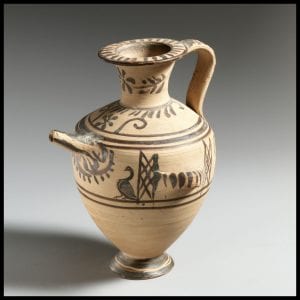 In our recent week of learning about and creating Greek pottery, I have researched a unique variety of different vessels and other ceramics made in ancient Greece. However, some have interested me more than others with their interesting forms and designs. In particular, a piece from the Metropolitan Art Museum, called the Terracotta Askos, is a drinking flask that strays from the traditional figure paintings and has a geometric-somewhat protogeometric-style. The designs on the flask, which include a very wide, wavy band of white and orange squares and animal designs, are a good representation of the earlier Classical period when human figure painting had not been popular yet and white shapes on black backgrounds were. As for the shape of the vessel, it has an efficient spout that seems to allow for drinks to easily be poured into and out of the flask. Along with this, a handle on the vessel increases the efficiency of the flask due to its ability to be carried around.
In our recent week of learning about and creating Greek pottery, I have researched a unique variety of different vessels and other ceramics made in ancient Greece. However, some have interested me more than others with their interesting forms and designs. In particular, a piece from the Metropolitan Art Museum, called the Terracotta Askos, is a drinking flask that strays from the traditional figure paintings and has a geometric-somewhat protogeometric-style. The designs on the flask, which include a very wide, wavy band of white and orange squares and animal designs, are a good representation of the earlier Classical period when human figure painting had not been popular yet and white shapes on black backgrounds were. As for the shape of the vessel, it has an efficient spout that seems to allow for drinks to easily be poured into and out of the flask. Along with this, a handle on the vessel increases the efficiency of the flask due to its ability to be carried around. 
Another vessel I took interest in was called the Terracotta Feeding Bottle. Features on the vessel that would make it a feeding bottle are its tea pot-like spout and handle as well as a wider mouth at the top they would enable liquids to be poured into the vessel. As well as these features, the vessel also includes a built-in straw. For the embellishments on the bottle, the visuals are of simple black leaf patterns and birds, embodying the Hellenistic period’s vessels that also include simple black figures and designs on white backgrounds.
These two vessels both heavily represent the importance of institutes such as The Metropolitan Museum and their desire to preserve and display artworks from ancient cultures as they show to the world where we came from over the course of centuries in art and what inspires us today with art. For example, the two vessels I have talked about both have forms and features that we were inspired by and use today in our cups and pitchers, such as wide spouts and handles for easy use. We also learn from our mistakes and flaws in past pieces and work to make them more efficient, such as adding lids to cups and pitchers to preserve the drink inside from the outer world. In the end, we need the ancient world to go and move forward with our future.

 As of this week in pottery, I have began construction on my own Greek-inspired vessel. So far, I have completed a vessel base and a wall made up of at least 6-7 layers of coils. Being more of an amateur at coiling building, which is the main way I intend on creating my vessel, the process has been less than easy as I have experienced many occurrences of trial and error over the course of three work days. However, I have been able to learn from my attempts and try things a new way. For instance, my first vessel-which was eventually scrapped-had lazily done coils that had not been smoothed out well, leading to dry, uneven, and crooked walls that later became unable to be fixed. From this try, I came out knowing to pay much more time into making each coil just as smooth and even as the other, which is a skill I particularly struggle with in coil building. To continue to refine my piece in ways like this, I think the most vital thing I must do is to spend the needed time in keeping the piece even and neat using techniques such as using rubber ribs to keep the walls upright and serrated edge scrappers to assist in making coil smoothing more efficient. Otherwise, I will end up repeating what happened the first time I attempted the piece.
As of this week in pottery, I have began construction on my own Greek-inspired vessel. So far, I have completed a vessel base and a wall made up of at least 6-7 layers of coils. Being more of an amateur at coiling building, which is the main way I intend on creating my vessel, the process has been less than easy as I have experienced many occurrences of trial and error over the course of three work days. However, I have been able to learn from my attempts and try things a new way. For instance, my first vessel-which was eventually scrapped-had lazily done coils that had not been smoothed out well, leading to dry, uneven, and crooked walls that later became unable to be fixed. From this try, I came out knowing to pay much more time into making each coil just as smooth and even as the other, which is a skill I particularly struggle with in coil building. To continue to refine my piece in ways like this, I think the most vital thing I must do is to spend the needed time in keeping the piece even and neat using techniques such as using rubber ribs to keep the walls upright and serrated edge scrappers to assist in making coil smoothing more efficient. Otherwise, I will end up repeating what happened the first time I attempted the piece. To form my sketches for the piece, I took heavy inspiration in the uses for ancient Greek vessels. For example, many of the pieces had lengthy necks and wider bodies to create a way to easily pour or drink liquids. Though I will not be using my vessel for these purposes, I took influence in this for historical accuracy purposes. To translate this shape on to a template, I had to consider the form I was going for and make sure to not make a piece with a large body that would be too short and odd looking. Furthermore, I had to make a template that did not include where the base of the piece was. Now further into the piece, I see that I have made the right decision in doing this as everything looks more proportionate. However, also when working on the piece, the vessel became much wider than planned and I met the problem of keeping the base eye-pleasing when put with the large base. To do this, I created a new base that translated correctly and kept the whole vessel stable and intact. From this, I have lead myself down a more successful and efficient route in my vessel-building process.
To form my sketches for the piece, I took heavy inspiration in the uses for ancient Greek vessels. For example, many of the pieces had lengthy necks and wider bodies to create a way to easily pour or drink liquids. Though I will not be using my vessel for these purposes, I took influence in this for historical accuracy purposes. To translate this shape on to a template, I had to consider the form I was going for and make sure to not make a piece with a large body that would be too short and odd looking. Furthermore, I had to make a template that did not include where the base of the piece was. Now further into the piece, I see that I have made the right decision in doing this as everything looks more proportionate. However, also when working on the piece, the vessel became much wider than planned and I met the problem of keeping the base eye-pleasing when put with the large base. To do this, I created a new base that translated correctly and kept the whole vessel stable and intact. From this, I have lead myself down a more successful and efficient route in my vessel-building process.